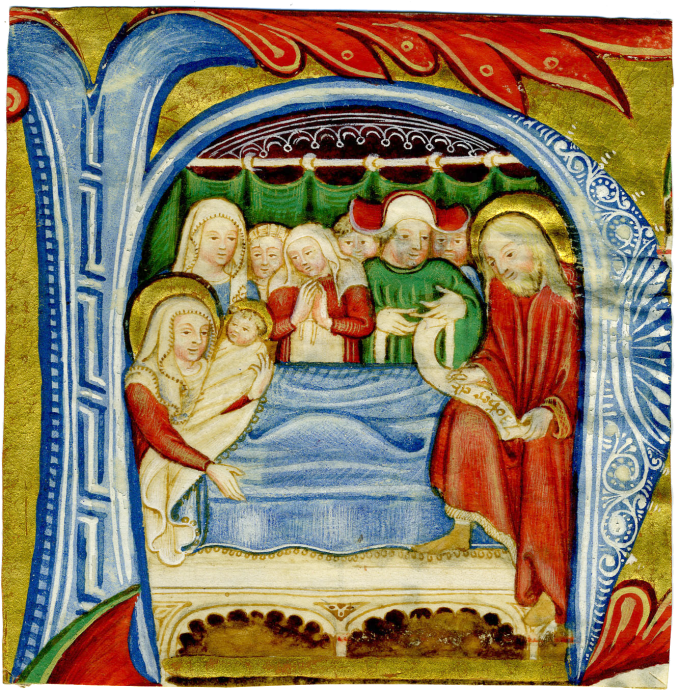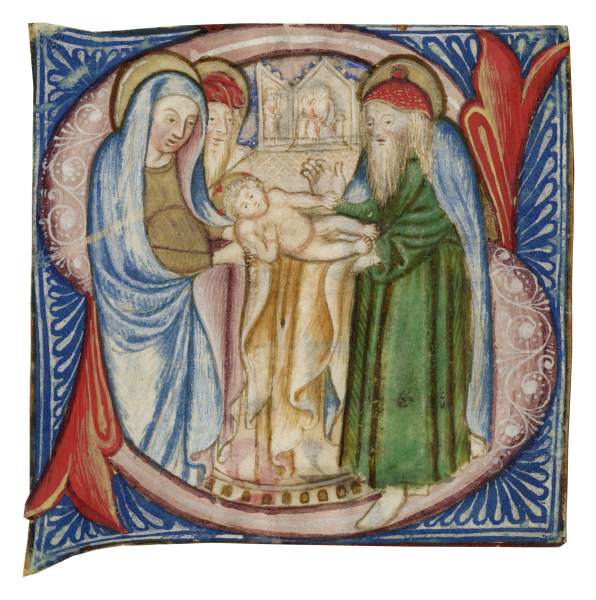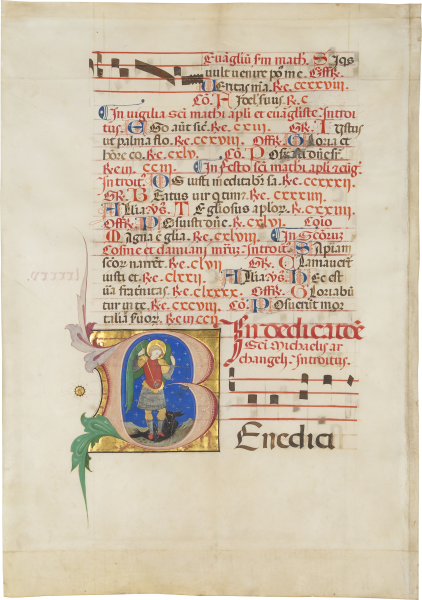


Description
The artist known as the Olivetan Master signed a miniature now in the Cini Foundation, frater mediolanensis ordinis montis oliveti ... MCCCXXXVIII (“The work was completed in 1439 by the friar of the Olivetan Order in Milan”). According to a recent hypothesis put forward by Anna Melograni, he was named Frater Jeronimus, he was ordained in 1429 in the monastery of Santa Maria di Baggio near Milan. Between 1431 and 1437, he was at San Girolamo di Quarto in Genoa, in Venice in 1433, then in Padua, Bologna, and Pistoia. He died in 1449. Distinctive collaborators, who were quite skillful but who have yet to be identified properly, worked with the Olivetan Master, whose style was also shaped by contact with the Master of the “Vitae Imperatorum”.
Their analogous style and comparable dimensions suggest that this initial, along with a sister leaf illustrating the Calling of Peter and Andrew, comes from the same Choir Book, which further documents the activity of an illuminator whose artistic formation was in the workshops of the Master of the Vitae Imperatorum and the Olivetan Master, the latter probably identified with the friar Jeronimus of Milan. The role these two workshops played in the production and decoration of both liturgical and secular manuscripts during the middle decades of the Quattrocento in Lombardy is gradually emerging thanks to the continuing publication of manuscripts and cuttings attributable to the two principal artists and to their collaborators.
Our illuminator in particular seems to have known several illuminated codices by the Master of the Vitae Imperatorum. Compare, for example, the Meditationes Vitae Christi (Milan, Biblioteca Trivulziana, Cod. 543), Boccaccio's Filocolo in Kassel (Landesbibliothek) and a Dittamondo by Fazio degli Uberti in Paris (BnF, MS it. 81). The only manuscript that is securely dated from this group is the Dittamondo in Paris. In 1447, Andrea Morena da Lodi signed and dedicated this manuscript to Cristoforo Cassano del Pozzo. Since the Filocolo and the Meditationes Vitae Christi are stylistically harmonious with the Dittamondo in Paris, they must therefore date from around the same time. Our illuminator shares with the anonymous master of these codices the simplified spatial construction of his scenes. In the Birth of Saint John the Baptist the interior is evoked only by a curtain that closes off the background, while in the Calling of Saints Peter and Andrew the landscape is treated conventionally. The rocky stratification of the background speckled with the little trees and the curling waves of the water on the lake where Jesus encounters the apostles are features that occur also in an illumination of Christ appearing to his disciples in the Meditationes in Milan (fol. 45v). Also the thin application of paint in a technique close to watercolor, which often exposes the under drawings on the ivory ground of the parchment, is similar to the technique found in the Milan codex (fig. 1).
Our artist is differentiated from the Master of the Vitae Imperatorum, however, by the more conventional treatment of his physiognomies and by his preference for a soft, almost intimate rhythm to the compositions, both of which are features that would seem to be closer to the Olivetan Master. A significant parallel within the workshop of the Olivetan Master is certainly the hand that Anna Melograni (1984, p. 288) has recognized in a cutting of the Conversion of Saint Paul (Philadelphia, Free Library, Lewis Collection. MS 27:25) with which, in my opinion, it may now be possible to group three other initials: a Saint Peter Enthroned (D.337.1893, MS 1012), a Saint Peter Liberated from Prison (D.333.1893, MS 1008), and a Conversion of Saint Paul (D.335.1893, MS 1010) now in the Victoria and Albert Museum in London.
Thus, it is probable that this initial and its sister leaf documents the activity of an artist who was a collaborator of the Olivetan Master and that they date around the fifth decade of the century because of the stylistic consistency with three other initials also published by Melograni, an Adoration of the Magi (New York, Pierpont Morgan Library, M.558 C), and a Pentecost and Creation of the Universe (Ithaca, Cornell University, Olin Library, MS B68, fols. 1v and 165v.)
We are grateful to Milvia Bollati for her expertise.
Literature
A. Melograni, "Appunti di miniatura lombarda. Ricerche sul Maestro delle Vitae Imperatorum," in Storia dell'arte, 70 (1990), pp. 274-314.
A. Melograni, "Miniature inedite del Quattrocento lombardo," in Storia dell'arte, 82 (1994), pp. 283-302.
M. Bollati, in Biblioteca Trivulziana. Milano, Fiesole, 1995, p.9

